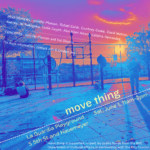In honor of the upcoming River to Creek bicycle tour on September 11, I’d like to share some thoughts that came up during a tour with our accompanying expert, Ryan.
On July 11, 2010 I took a bike tour of the Newtown Creek with Ryan Kuonen of Neighbors Allied for Good Growth (NAG), a volunteer-based community planning and environmental justice organization that has worked in North Brooklyn waterfront communities for many years. The tour was offered as a course at the School of the Future.
Ryan is stuffed full of knowledge about the history and ecological state of the creek, and led us to unusual access points along the creek. Some interesting tid-bits from the smorgasboard of information she offered:
– There is an oil spill under the creek that is bigger than the spill from the Exxon Valdez.
– The Newtown Creek wastewater treatment plant has a visitor’s center which was designed by Vito Acconci and New York City DCA Percent for Art brought us the George Trakas sculptural habitat on the grounds of the treatment plant. This habitat, a large public area that contains gardens and a unique spatial design, is hidden away at the end of Paidge Avenue and surprisingly uninhabited, given its unusual and gorgeous nature. It has been a stop on some the River to Creek research tours.
– In the past 400 years, the area around Newtown Creek has gone from productive wetland to farmland to heavy waterfront industry to light functioning industry with less waterfront activity and is currently transforming, albeit slowly, into residential areas with waterfront access.
Here are some photos of some flora and fauna along the creek, and some waterfront views from the bike ride:

The ride and the talk started me thinking about the intersection between art, activism and science.
Ryan, a passionate advocate for environmental justice, had a plethora of scientific knowledge at her fingertips. This type of knowledge is essential for a certain type of activism. Activism aimed at our ecological survival (aka survival of life on Earth) requires science.
Where does art fit? In a space.
Ideally, art brings the message home, under the skin and into the tear ducts, through the soles of the feet and into the blood stream.
Perhaps art is the intersection of information, education and understanding.
Art acts in this space not just by presenting information in an attractive manner. It is the intermediary between the raw experience of the world/event that is eventually translated into “information” and the information it becomes. It is privileging our sensory and other perception, our nuanced intuition, and it allows us to become utterly engaged in a situation.
I propose:
Environmental activism needs science to be effective as information and it needs art to be effective in creating true understanding. Also, environmental science needs environmental activism so that it can remain vital and connected to everyday life, and environmental science needs art so that there is a connection between analysis (taking the world apart into its constituent pieces) and synthesis (putting the pieces back together in unusual ways). And—environmental science stimulates art to create a connection between ideas and physical reality, while environmental activism has given rise to some of the many of the most interesting expressions of artistic creativity in the past decade or so, giving the creative process a boost into a socially engaged yet esthetically rigorous realm.
Comments welcome. And we look forward to seeing you on Sept. 11 for a vigorous ride through the wilds of the industrial Creek, crazy environmental facts and discussion, and birdwatching.
Clarinda for River to Creek


















[…] Art, science, activism, and bicycles Share this:ShareFacebookTwitterLike this:LikeBe the first to like this post. […]